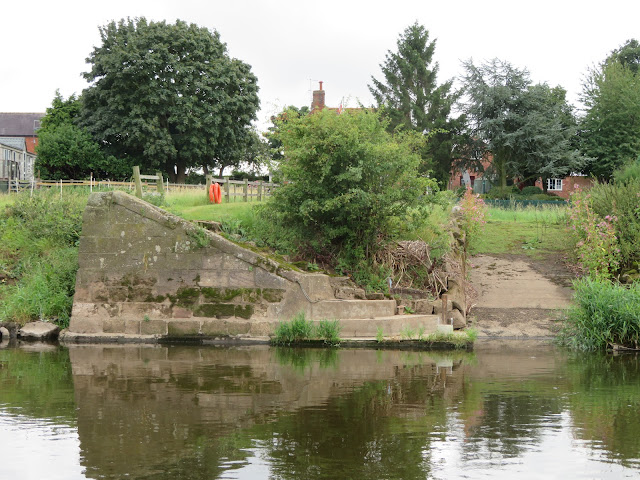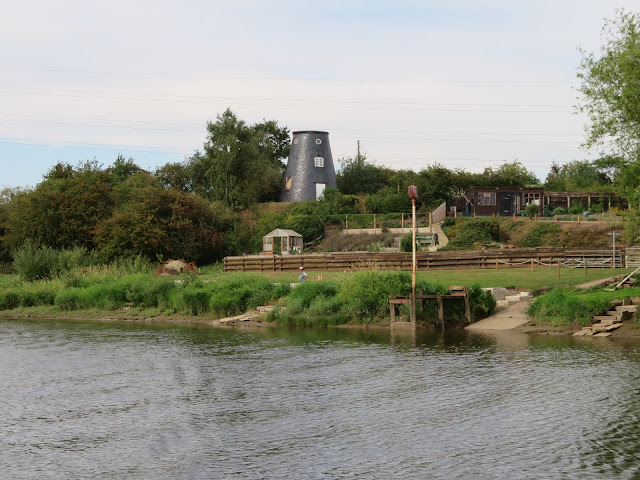Helen went into town for a few last minute bits and pieces and by just gone ten we called the lock to ask for a pen up and were obliged almost straight away. Once the lock the Lockie asked if the boat was moored at Hedon Haven. It turns out he used to work the fuel barges that would fill up in Hedon Haven before the mid 1960's at Salt End. I would have loved to chat to him longer but we had to leave. Maybe we will bump into him on the way back.
Newark has a great skyline. Not quite New York or London, but full of interest non the less. It seems that they are revamping the dry dock area above Town Lock. We have never moored up here, but they look as if they would be quite quiet.
Looking back at Town Lock it is a bit special to have the castle in the background. I suppose there is Fotherighay on the Nene, York on the Ouse and Lancaster on the Lancaster, but like this. It is special.
Between Newark and Farndon is this old building. The OS Map calls it the Maltings and the road it is on is called Mills Drive. There is obviously a wharf next to it so it used the river for commerce. It is a large building and you may have thought that it would make great apartments. If it is Maltings in mkay have low ceilings between floors. Bit another building that would be good to save somehow.

Averham Weir is over looked by Staythorpe Power Station. It is the third on the site. The first was built by Derbyshire and Nottinghamshire Electricity Board in 1946. The first reached max. output, 2000 GWh in 1958 after the generation was Nationalised in 1948. The second station was opened in 1962 and reached max output in 2500 GWh in 1963/64. It achieved an efficiency of 33%. These two power stations used coal to power them, brought by rail. This 3rd Power Station is powered by gas. It was originally planned and started construction in 1998 but was halted in 2000 due to saturation of the market. It was restarted in 2008. It is a combined cycle gas turbine and has an efficiency of 58%.
By the river can be seen this sculpture called 'Power in Trust' by Norman Stillman. It was made for the opening of Staythorpe B in 1961 and is made to represent a hand using boiler pipes and a turbine.
This is an old wharf and is where the old Roman Road, the Fosse Way comes closest to the Trent. It is an interesting construction. The slope has steps, to accommodate the different levels of the river I assume. I'm not sure how they would have used barrows to offload/load bulk cargoes.
Partly hidden behind trees and distance from the river is Stoke Hall.. It was built in 1812 and incorporating older buildings, possibly some of the St. Leonards Hospital founded in 1135! It is now a wedding venue, and is smaller now as some was demolished in the 1920's.
This boat is high and dry and must have been here for a while. It looks like it is lived on. I'm not sure what the land owner thinks of it.
Following the heavy floods in the country over the winter sandbanks have built up below some of the Trent Locks. The lock keeper warned me of the buoys. The little pellet buoys you can see in front of the lock mark the bank in front of Hazelford Lock. You have to sail right up to the lock, clear the buoys, and then turn into the lock.
Below the lock seemed to be full of boats so we did wonder if there was space above. We went up to fill with water and there was plenty of room. We walked across the weir bridge to drop off the rubbish and had a good view of the weir itself.
We tried to moor just around the corner but we got moored up and realised that there must be a massive wasps nests behind the piling as there were plenty of them flying out of small holes. It is very peaceful on the lock island with rabbits and blackberries. I picked some, blackberries, not rabbits, to go in some jam with some damsons and plums I had picked on the Chesterfield.





















































